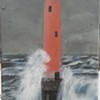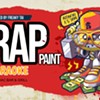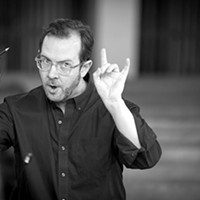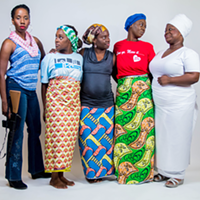In the great Miles Davis Quintets of the late 1950s, Davis was the foundation and the architecture on trumpet while tenor saxophonist John Coltrane was the flame-thrower who filled the building with dazzling light. There's a marvelous dialogue between Sultan Omar El-Min and Quentin Talley, who portray the two jazz titans in On Q Productions' Miles & Coltrane, that beautifully articulates the yin-yang of their musical chemistry.
Talley, the "Q" of On Q, filled the McGlohon Theatre stage with extensions of that alchemy. Two dancers from NC Dance Theatre, Randolph Ward and Jhe Russell, were choreographic shadows of the actors a la Moving Poets. An onstage quintet, fronted by Lynn Grissett Jr. on trumpet and John Alexander on tenor, played some of the great Miles-Trane hookups from the Kind of Blue album and other prime cuts from the Columbia years, including "Someday My Prince Will Come." Above them hovered murals of the jazz icons, and -- between the dialogues of the protagonists and the music/dance interludes -- two SlamCharlotte poetry champions, Charles "CP Maze" Perry and Fillmore Johnson, traded lyrical licks throughout the show.
El-Min's evocation of the raspy-voiced Davis was uncanny, and Talley provided him with more than enough biographical detail and distilled interview material to give us a fully-rounded portrait of dynamic depth. With Miles that means capturing his passion and his abrasiveness without ignoring his fascinating contradictions.
But there was a fascinating yin-yang within both of these great artists. Miles' music was incomparably delicate and soft in contrast with his abrasive, sometimes even racist public posturing. Trane's musical boldness and ferocity contrasts with a soft-spoken insouciance -- and a basically reclusive, self-absorbed persona off the bandstand.
So I didn't connect Talley's high-stylin' profilin' portrait of Coltrane with anything I'd read about him during the decades since he first captivated me with his electrifying "sheets of sound." Miles & Coltrane doesn't really begin to illuminate how membership in the Quintet became a transformative experience for Coltrane as a musician. The specious self-conceit Talley layers upon his portrait of the man gets in the way. Nor do we get to consider how Trane's explorations of New Jazz before his early death in the late 1960s might have fathered successive rebirths in Davis's musical thinking that led to his watershed Bitches Brew in 1969.
A portion of the lyrical profusion needs to give way for us to get more historical substance. We get one episode in the partnership that's dramatically true-to-life, Trane's temporary dismissal from the combo to kick his heroin addiction. Carlos Robson, my favorite SlamCharlotte poet, personified heroin in a wondrous saturnine cameo. Yet we leave with the impression that Trane was one in a long line of drug casualties made infamous by those celebrated Lady Day and Bird biopics. That's a distortion in need of a fix.
"Play the tapes," Miles repeatedly tells us if we wish to get to the core of the music, so there seems little reason for Grissett or Alexander to imitate their models on the bandstand. If you catch the next stage of this work-in-progress when it resurfaces, you'd probably recognize more of a kinship between Grissett and Miles than Alexander and Trane. The choreography, seemingly improvised, was more puzzling, Russell free and lithe as Trane and Ward cool and subdued as Miles ñ often inexplicably tethered to a stool. Hope he isn't injured.
After the wildly successful productions of A Day of Absence and For Colored Girls earlier this year, Miles & Coltrane is a reaffirmation of why Talley's triumph at the MTA Awards last Sunday night, in the Emerging Talent category, was so richly deserved. The On Q energy, synergy and excitement are unabated onstage, continuing to draw enthusiastic audiences. Talley and his On Q are clearly on target.
There were some conspicuously bare spots onstage at Belk Theater as Charlotte Symphony Orchestra launched its 77th season with Mozart and Mahler. Brass weren't needed and string were discreetly trimmed for a suite of two songs following the overture from Wolfgang's The Abduction from the Seraglio. Outgoing musical director Christof Perick, beginning his penultimate season with CSO, was actually outgoing! Not only did he introduce the context of the 1782 opera, he brought guest soloist Heidi Meier aboard with a trace of gallantry. There would be more showmanship after intermission as well.
Mozart has become a specialty during Perick's tenure, so all was well with the brisk, pointed rendition of the overture -- not too schizoid as we shuttled from one dynamic extreme to another, with just the right degree powerful punch when needed. Arias from Act 2 of Seraglio were even more delicious with Meier navigating the high notes and coloratura effortlessly. Hers isn't the fruitiest tone I've heard from a soprano, but the earnestness and resolute fidelity of Konstanze resounded powerfully through the hall. If Meier were acting the role instead of rooted in one spot in a formal dress, I'm sure we would have gotten the full power of "Matern all Arten" (Torture of every kind) -- and perhaps all the repeats.
Three trumpets played from backstage during the opening episode of the Titan symphony. Not only did a full complement of brass return for the Mahler, but a full bank of French horns besides -- eight of them. Upstage, in front of the Belk's vestigial organ, four percussionists, including two timpanists, were arrayed. Yet the arrival of Mahler's first symphony, postponed from a couple of seasons ago, still seemed premature.
No want of meticulous preparation could be detected as the sequence of pastoral and song episodes paraded by -- and the brass sounded downright regal once gathered into the hall. But the episodes remained fragmented parts rather than a slowly massing whole. The great cymbal crash wasn't a culmination. It was more like an alarum, a reveille, an improvised mustering of the orchestra. Tidiness re-established its reign over the second movement, and the 3/4 time was smartly accented and paced. It was novel to see the oboists playing their instruments perpendicularly, but I would much rather have heard Perick & Co. cross the gulf between Mozart and Mahler.
It happened in the final two movements. After doublebass principal Ivan Zugelj launched the solemnly-tinged "Frere Jacques" theme, there was that massing of orchestral forces that evokes the storms of Beethoven and the phantasmagoria of Berlioz. This was Mahler! OK, there wasn't quite as much wild insanity peeping into the third movement as there might be, or as much pure sweet joy taking over the climax of the finale that a few more bodies in the violin section might deliver.
But despite some fluffs by the horns, the place rocked. The explosive expostulations of trumpets and violins, backed by a double timpani volley, merited a visceral response as Perick launched the fourth and final movement. Oboes, four of them, lifted to the perpendicular again, and all eight French hornists stood up for their final flourishes. All were tight and together for their group close-up. More important, the enthusiastic reaction of subscribers to the concluding musical majesty looked like Charlotte had finally embraced Mahler -- and the sound of a full-sized orchestra.
Latest in Performing Arts
More by Perry Tannenbaum
Calendar
-

WHISKEY TASTING: VIRGINIA HIGHLANDS WHISKY @ Elizabeth Parlour Room
-

NEW WINDOW GALLERY-Pat Rhea-ACRYLIC PAINTINGS-April 05-30 2024 VALDESE, NC 28690 @ New Window Gallery/Play It Again Records
- Through April 30, 12 p.m.
-
An Evening With Phil Rosenthal Of "Somebody Feed Phil" @ Knight Theater
-
Kountry Wayne: The King Of Hearts Tour @ Ovens Auditorium
-

Trap & Paint + Karaoke @ Zodiac Bar & Grill
-
Susan Brenner Examines Upheaval While Celebrating Trees
Chaos and beauty
-
Jessica Moss Makes the Gantt Center a Safe Zone for Local Artists 2
Flipping the script
-
Breaking the Moon musical brings light to dark side 12
A Teenie Galaxy















